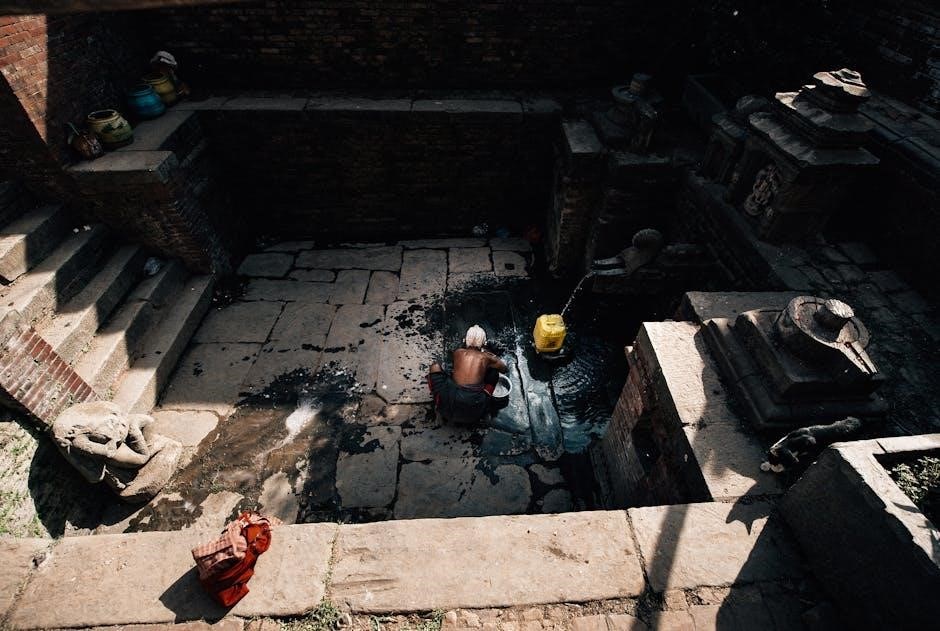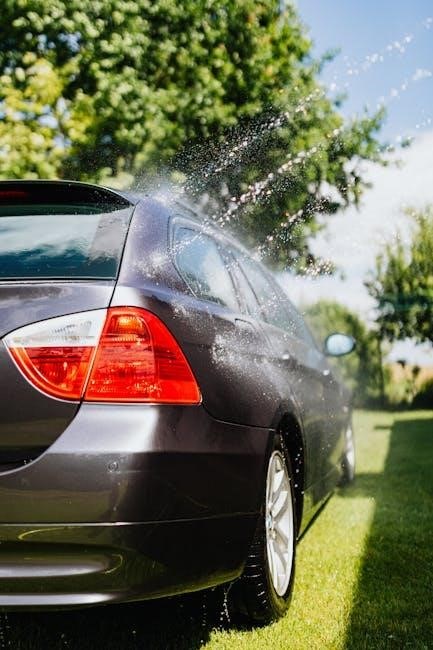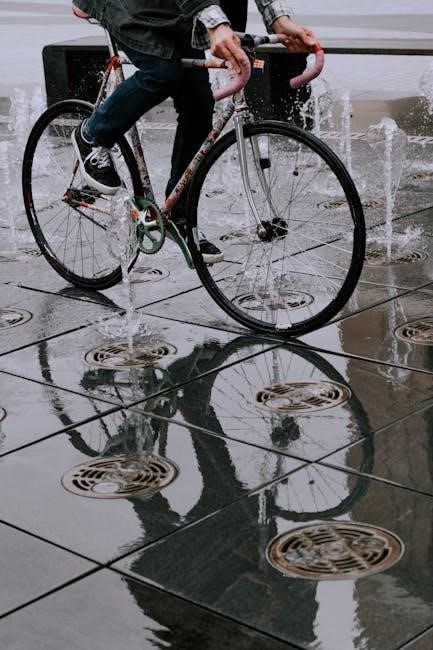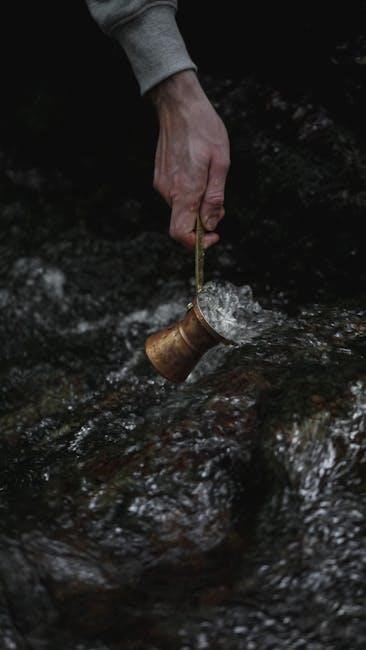This manual provides comprehensive guidance for installing, operating, and maintaining the Clack Water Softener. It covers key features, troubleshooting, and maintenance tips to ensure optimal performance and water quality.
1.1 Purpose of the Manual
This manual serves as a comprehensive guide for understanding, installing, and maintaining the Clack Water Softener system. Its primary purpose is to provide detailed instructions and technical specifications to ensure proper setup and operation. Designed for water treatment professionals and homeowners alike, the manual covers essential aspects such as system components, safety precautions, and troubleshooting. It also includes step-by-step installation processes and maintenance schedules to maximize the longevity and efficiency of the water softener. By following the guidelines outlined in this manual, users can optimize water quality, reduce hardness, and extend the lifespan of their system. Whether you’re a novice or an experienced user, this manual offers clear, actionable information to address all your water softening needs.
1.2 Key Components of the Clack Water Softener
The Clack Water Softener system consists of several essential components that work together to provide efficient water softening. The primary elements include the control valve, resin tank, brine tank, and bypass valve. The control valve, often a WS1 or WS1.25 model, regulates water flow and manages the regeneration process. The resin tank houses the ion-exchange resin, which removes calcium and magnesium ions from the water. The brine tank stores salt solution used during regeneration to recharge the resin. The bypass valve allows for easy isolation of the softener during maintenance or regeneration. Additional components include drain line flow controls, brine line flow meters, and interconnect cables for system communication. These parts are designed to ensure smooth operation, optimal water softening, and minimal user intervention. Proper functioning of each component is crucial for maintaining water quality and system efficiency.
1.3 Benefits of Using a Clack Water Softener
Using a Clack Water Softener offers numerous benefits, primarily by providing soft water that protects plumbing, appliances, and skin from hard water damage. It reduces scaling in pipes, extends the lifespan of water-using appliances, and enhances the effectiveness of soaps and detergents. Soft water also improves the taste and odor of drinking water, making it more pleasant for consumption. The system’s advanced control valve ensures efficient operation, minimizing water and salt usage. Regular regeneration cycles maintain optimal performance, while features like automatic bypass and manual override provide convenience. Additionally, the Clack Water Softener is designed to reduce maintenance needs and operational costs. Its ability to remove harmful minerals and impurities ensures cleaner, healthier water for households. Overall, the Clack Water Softener is a reliable solution for improving water quality, reducing hard water issues, and enhancing daily comfort and convenience.
1.4 Safety Precautions
When installing and operating the Clack Water Softener, it is essential to follow safety precautions to avoid potential hazards. Ensure the system is installed by a qualified professional, adhering to local plumbing codes and regulations. Always disconnect the power supply before performing maintenance or repairs to prevent electrical shock. Keep children and pets away from the unit to avoid accidental tampering. When handling chemicals, such as salt or sanitizing solutions, wear protective gloves and eyewear. Properly vent the area to prevent inhalation of fumes. Regularly inspect the system for leaks or damage to prevent water damage or contamination. Follow the manufacturer’s instructions for any chemical additions to the brine tank. Finally, ensure the drain line is correctly installed and meets the specified height requirements to prevent overflow and ensure proper regeneration cycles. Adhering to these safety guidelines will help maintain a safe and efficient water softening system.

Installation Guide
This section provides detailed instructions for installing the Clack Water Softener, including pre-installation requirements, step-by-step processes, and connecting components like the bypass valve and drain line.
2.1 Pre-Installation Requirements
Before installing the Clack Water Softener, ensure the following pre-installation requirements are met. First, choose a suitable location with adequate space and access to water supply lines. The area should be level and protected from freezing temperatures. Next, verify the water hardness level to determine the appropriate system settings. Ensure the electrical supply meets the system’s power requirements. Additionally, check the drain line requirements; if the drain line exceeds 20 feet, upgrade to a 3/4″ line. Review local plumbing codes and regulations to ensure compliance. Lastly, gather all necessary tools and components, such as Teflon tape, wrenches, and connectors, to facilitate a smooth installation process. Proper preparation ensures a trouble-free setup and optimal performance of the water softener system.
2.2 Step-by-Step Installation Process
Begin by ensuring the bypass valve is in the “bypass” position to stop water flow. Connect the inlet and outlet pipes to the water softener, securing them with Teflon tape. Next, install the drain line, ensuring it meets local plumbing codes and does not exceed 20 feet without upsizing to 3/4″. Connect the electrical supply to the control valve, following the manufacturer’s wiring diagram. Mount the control valve and program it according to the system’s specifications, setting water hardness levels and regeneration cycles. Finally, flush the system by running a manual regeneration cycle to remove air and debris. Once complete, test the water softener to ensure proper operation and adjust settings as needed. Proper installation ensures efficient performance and longevity of the system.
2.3 Connecting the Bypass Valve
Connecting the bypass valve ensures uninterrupted water supply during maintenance. Locate the bypass valve, typically positioned near the water softener. First, identify the inlet and outlet ports, ensuring they align with your plumbing setup. Attach the inlet pipe to the “in” port and the outlet pipe to the “out” port, using Teflon tape for a leak-free seal. Tighten the connections firmly but avoid overtightening to prevent damage. Position the valve so the flow arrow points towards the softener for correct water direction. Finally, test the valve by switching between “bypass” and “service” modes to ensure smooth operation. Proper installation prevents leaks and ensures efficient system performance. Refer to the manual for specific torque recommendations and valve positioning guidelines to avoid potential issues.
2.4 Initial Setup and Programming
After installation, the initial setup involves configuring the control valve settings. Begin by connecting the interconnect cable to the control valve board for proper communication. Set the water hardness level by pressing and holding the hardness button until the desired level is displayed. Adjust the regeneration times according to your water usage patterns. For manual regeneration, press and hold the REGEN button for three seconds to initiate the cycle. Ensure the bypass valve is in the correct position to allow water flow during normal operation. Refer to the manual for specific instructions on programming modes, such as NORMAL or FILTER modes. Proper setup ensures the system operates efficiently and maintains optimal water quality. Regularly review and update settings as needed to adapt to changes in water usage or hardness levels. This step is crucial for maximizing the system’s performance and longevity.

Operating the Clack Water Softener
Operating the Clack Water Softener involves daily monitoring of water flow and hardness levels. Regularly check the control valve settings and initiate manual regeneration if necessary to maintain optimal performance.
3.1 Daily Operation and Monitoring
Daily operation of the Clack Water Softener requires minimal effort but consistent monitoring. Start by ensuring the system is powered on and the control valve is set correctly. Check the salt levels in the brine tank regularly to prevent depletion, as low salt levels can lead to ineffective regeneration. Monitor water hardness by testing the output water periodically, ensuring it meets your desired softness. Inspect the drain line for any blockages or kinks that could disrupt regeneration cycles. Additionally, listen for unusual noises during operation, as they may indicate issues with the control valve or resin bed. Regularly review the control valve’s display for error codes or alerts, addressing them promptly to avoid system downtime. Finally, maintain a routine of cleaning the brine tank and checking for any signs of wear on the system’s components. This daily oversight ensures the softener runs efficiently and effectively.
3.2 Manual Regeneration Process
The manual regeneration process on the Clack Water Softener allows you to initiate a regeneration cycle outside of the programmed schedule. To start, ensure the bypass valve is in the “service” position to prevent untreated water from flowing through the system. Press and hold the REGEN button for three seconds until the control valve display confirms the cycle has begun. The system will then progress through the backwash, brine rinse, and fast rinse phases to restore the resin bed’s capacity. Manual regeneration is useful for addressing specific water quality issues or after a prolonged period of non-use. Always monitor the process to ensure it completes successfully and check for any error codes. After regeneration, open the bypass valve slowly to allow water to flow back into the system, expelling any air trapped during the cycle. This ensures optimal performance and water quality. Regular manual regeneration can help maintain system efficiency and extend its lifespan.
3.3 Programming the Control Valve
Programming the Clack Water Softener control valve allows you to customize settings such as water hardness, regeneration times, and day override. To access the programming menu, press and hold the NEXT and button simultaneously for 2 seconds. Use the buttons to navigate through options like hardness setting, regeneration start times, and day override. Enter the desired water hardness level based on your local water conditions. For regeneration timing, select the preferred time and day for the system to regenerate automatically. The day override feature allows you to pause regeneration for a specific day if needed. After setting your preferences, save the changes to ensure they take effect. For new systems, it may be necessary to run two manual regenerations to fully charge the resin bed. Refer to the control valve display for confirmation and ensure all settings align with your water treatment needs for optimal performance.
3.4 Understanding the Regeneration Cycle
The regeneration cycle is a critical process for restoring the Clack Water Softener’s ion exchange capacity. It involves four main phases: backwash, brine injection, rinse, and refill. During backwash, water flows through the resin bed in reverse to remove debris. Next, brine injection introduces saltwater to recharge the resin, replacing calcium and magnesium ions with sodium. The rinse phase flushes the brine and residual hardness from the resin, ensuring clean water for service. Finally, the refill phase replenishes the brine tank with fresh water and salt. The cycle is typically automatic but can be manually triggered if needed. Understanding these phases helps optimize water softening efficiency and ensures consistent water quality. Proper regeneration maintains system performance and extends the lifespan of the resin and control valve. Regular monitoring of the regeneration cycle is essential for troubleshooting and maintaining optimal water softening results.

Maintenance and Troubleshooting
Regular maintenance ensures optimal performance and longevity of the Clack Water Softener. Check salt levels, clean the brine tank, and inspect drain lines. Address common issues like low water pressure or salt bridges promptly.
4.1 Regular Maintenance Tasks
Regular maintenance is essential to ensure the Clack Water Softener operates efficiently. Check salt levels monthly and refill as needed to prevent bridging. Clean the brine tank every 3-6 months by dissolving any hardened salt. Inspect the drain line for blockages and ensure proper flow. Replace the resin bed every 5-10 years, depending on usage and water hardness. Lubricate moving parts annually to maintain smooth operation. Monitor water hardness and adjust settings if necessary. Perform manual regeneration cycles periodically to clean the system thoroughly. Keep the control valve free from debris and ensure all connections are secure. Regular maintenance prevents common issues like reduced water flow or inconsistent softening performance, ensuring your water remains soft and your system runs smoothly for years to come.
4.2 Common Issues and Solutions
Common issues with the Clack Water Softener include low water pressure, system not softening water, high salt usage, and leaks. For low water pressure, check the bypass valve settings and ensure the resin bed is not blocked. If the system fails to soften water, verify the control valve programming and ensure the salt level is adequate. High salt usage may indicate improper settings or stuck valves, requiring adjustment or replacement. Leaks often occur from loose connections or worn seals, which should be tightened or replaced. Strange noises during operation may signal trapped air or malfunctioning components, which can be resolved by cycling the system or replacing faulty parts. Regular maintenance and troubleshooting can address these issues effectively, ensuring optimal performance and water quality. Always refer to the manual for specific solutions and guidelines to resolve problems promptly and prevent further complications.
4.3 Checking and Replacing Parts
Regular inspection of the Clack Water Softener’s components is essential for long-term efficiency. Start by examining the resin bed for signs of wear or depletion, which may require replacement every 5-10 years depending on usage. The control valve should be checked for proper function, ensuring all cycles operate smoothly. If leaks are detected, inspect the O-rings and seals for damage or mineral buildup, replacing them as needed. The brine tank and drain line should be cleaned periodically to prevent blockages. If the system fails to regenerate, check the electrical connections and ensure the control valve is programmed correctly. For parts replacement, refer to the manual for compatible models and follow the step-by-step instructions. Always turn off the water supply and discharge the system before performing maintenance. Use diagnostic error codes to identify specific issues and address them promptly to maintain optimal performance and extend the system’s lifespan.
4.4 Advanced Troubleshooting Techniques
For complex issues with your Clack Water Softener, advanced troubleshooting techniques can resolve persistent problems. Start by reviewing the system’s diagnostic error codes, which provide specific insights into malfunctions. Check for inconsistent water pressure or flow rates, as these can indicate clogged filters or faulty valves. If the softener fails to regenerate, ensure the control valve is properly programmed and that the resin bed is not saturated. Perform a manual regeneration cycle to reset the system and clear any blockages. Inspect the brine tank for adequate salt levels and ensure the drain line is unobstructed. For persistent hard water issues, test the water hardness levels post-treatment to confirm the system’s effectiveness. If problems persist, consult the troubleshooting guide or contact a certified technician for professional assistance. Regular advanced checks help maintain optimal performance and extend the lifespan of your water softener.

The Control Valve Explained
The Clack control valve is a fully automatic, glass-filled Noryl valve that regulates water softener cycles, including regeneration, backwash, and rinse. It is the system’s primary control center, ensuring efficient operation.
5.1 Features of the Clack Control Valve
The Clack control valve offers advanced features designed to optimize water softening processes. It supports both downflow and upflow regeneration, making it versatile for various system configurations. The valve is constructed with durable glass-filled Noryl, ensuring long-lasting performance. It includes a user-friendly interface for easy programming and monitoring, allowing users to set regeneration cycles, hardness levels, and override settings. The valve also features diagnostic capabilities, providing error codes to help identify and resolve issues quickly. Its design allows for smooth operation during regeneration, backwash, and rinse phases, ensuring minimal disruption to water supply. Additionally, the control valve supports manual regeneration, enabling users to initiate cycles as needed. These features make the Clack control valve a reliable and efficient component for water softening systems, ensuring consistent water quality and system durability.
5.2 Configuring the Control Valve
Configuring the Clack control valve involves setting parameters to match your water treatment needs. Begin by connecting the interconnect cable to the control valve board for system integration. Access the hardness setting by pressing and holding the NEXT and another button simultaneously for 2 seconds. Input the water hardness level, day override, and regeneration times as required. For new installations, run two manual regenerations to fully charge the resin. Programming during commissioning ensures proper system calibration and air removal. Use the REGEN button to initiate manual cycles if needed. Ensure all settings align with your water softener’s specifications for optimal performance. Proper configuration ensures efficient operation, consistent water quality, and prolonged system life.
5.3 Understanding Regeneration Modes
The Clack water softener operates through various regeneration modes to ensure efficient ion exchange and system longevity. The primary modes include downflow regeneration, where water flows downward through the resin, and upflow regeneration, used for specific applications like iron removal. During regeneration, the system performs a series of steps: backwash to clean the resin, brine draw to recharge it, slow rinse to repack the bed, and fast rinse to clear brine. The control valve automates these cycles based on water usage or time. Manual regeneration can be initiated via the REGEN button for immediate cleaning. Understanding these modes helps optimize water treatment efficiency and maintain soft water quality. Proper mode selection ensures the system adapts to your water conditions, providing consistent performance and extending the life of the resin. Regular monitoring of regeneration cycles is essential for troubleshooting and ensuring optimal operation.
5;4 Diagnostic and Error Codes
The Clack water softener features a diagnostic system that displays error codes to identify issues. These codes, such as Err1 or Err2, indicate problems like low salt levels or flow restrictions. Refer to the manual for specific code meanings. The control valve’s display flashes codes to alert users of system malfunctions, allowing timely troubleshooting. For example, a flashing light may signal a stuck valve or high water pressure. By addressing these codes, users can prevent damage and maintain efficiency. Regular checks ensure smooth operation and extend the system’s lifespan. Understanding error codes empowers users to resolve issues independently, minimizing downtime and ensuring consistent soft water supply. Always consult the manual or contact support for complex diagnostics. Proper error code management is crucial for maintaining optimal performance and water quality. This feature enhances user experience by providing clear, actionable feedback.

Additional Resources
For further assistance, refer to the warranty information, download the full manual, or contact customer support. Online forums and communities also offer valuable insights and troubleshooting tips for your Clack water softener.
6.1 Manufacturer Warranty Information
Clack Corporation offers a comprehensive warranty for their water softener systems. The warranty typically covers the control valve and other components for a specified period, ensuring protection against manufacturing defects. The limited warranty is designed to provide peace of mind, with terms varying depending on the model and usage. For detailed information, refer to the official warranty documentation provided with your system or available on the Clack Corporation website. Proper installation and maintenance are essential to uphold warranty validity. Any issues arising from improper installation or misuse may not be covered. Contact customer support for warranty claims or clarifications. Always retain your purchase receipt and documentation for warranty verification. This ensures your Clack water softener operates effectively under the manufacturer’s guarantee.
6.2 Downloading the Full Manual
The full Clack Water Softener Manual is readily available for download on the official Clack Corporation website. To access it, navigate to the “Support” or “Resources” section, where you can find a dedicated page for manuals and guides. The manual is typically provided in PDF format, ensuring easy viewing and printing. Simply locate your specific model, such as the WS1 or WS1.25 series, and follow the prompts to download the document. This comprehensive guide covers installation, operation, maintenance, and troubleshooting, making it an essential resource for optimal system performance. For convenience, you can also search for the manual using the model number on popular search engines or forums. Always ensure you download from a trusted source to avoid outdated or incorrect information. Refer to the manual regularly to maximize the efficiency and lifespan of your Clack Water Softener system.
6.3 Contacting Customer Support
For assistance with your Clack Water Softener, contact Clack Corporation’s customer support team. They can be reached via phone at 608.846.3010 or through email for inquiries and troubleshooting. The support team is available to address questions about installation, operation, and maintenance. Additionally, the Clack Corporation website provides detailed contact information, including their office location at 4462 Duraform Lane, Windsor, WI 53598. For urgent issues, it is recommended to call during business hours. The customer support team is equipped to help with warranty claims, technical difficulties, and general guidance. They also offer resources for troubleshooting common problems and can direct you to authorized service providers if needed. Ensure to have your model number and serial number ready for faster assistance. Clack Corporation is committed to providing reliable support to ensure your water softener operates efficiently.
6.4 Online Forums and Communities
Engaging with online forums and communities is an excellent way to connect with other Clack Water Softener users and experts. Platforms like Clack Corporation’s official forum and independent water treatment communities provide valuable resources, troubleshooting tips, and user experiences. These forums often feature discussions on installation, maintenance, and optimizing your water softener’s performance. Additionally, you can find guides and tutorials shared by experienced users, which can be helpful for resolving common issues or understanding advanced features. Many forums also host experts who can offer personalized advice and solutions. Participating in these communities can enhance your understanding of the Clack Water Softener and help you troubleshoot problems more effectively. Active engagement allows you to share tips, learn from others, and stay updated on best practices for maintaining your system. These online spaces are invaluable for fostering a supportive environment among users and professionals alike.
